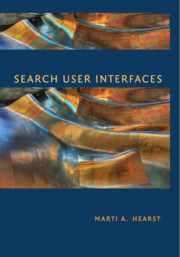Book contents
- Frontmatter
- Contents
- Preface
- 1 The Design of Search User Interfaces
- 2 The Evaluation of Search User Interfaces
- 3 Models of the Information Seeking Process
- 4 Query Specification
- 5 Presentation of Search Results
- 6 Query Reformulation
- 7 Supporting the Search Process
- 8 Integrating Navigation with Search
- 9 Personalization in Search
- 10 Information Visualization for Search Interfaces
- 11 Information Visualization for Text Analysis
- 12 Emerging Trends in Search Interfaces
- Appendix: Additional Copyright Notices
- Bibliography
- Index
- Author Index
- Plate section
3 - Models of the Information Seeking Process
Published online by Cambridge University Press: 05 March 2013
- Frontmatter
- Contents
- Preface
- 1 The Design of Search User Interfaces
- 2 The Evaluation of Search User Interfaces
- 3 Models of the Information Seeking Process
- 4 Query Specification
- 5 Presentation of Search Results
- 6 Query Reformulation
- 7 Supporting the Search Process
- 8 Integrating Navigation with Search
- 9 Personalization in Search
- 10 Information Visualization for Search Interfaces
- 11 Information Visualization for Text Analysis
- 12 Emerging Trends in Search Interfaces
- Appendix: Additional Copyright Notices
- Bibliography
- Index
- Author Index
- Plate section
Summary
In order to design successful search user interfaces, it is necessary to understand the human information seeking process, including the strategies people employ when engaged in search. Numerous theoretical treatments have been proposed to characterize this complex cognitive process (Belkin et al. 1982; Jarvelin and Ingwersen 2004; Kuhlthau 1991; Marchionini 1995; Saracevic 1997; Sutcliffe and Ennis's 1998). This chapter presents the most commonly discussed theoretical models of the search process: the standard model, the cognitive model, the dynamic model, search as a sequence of stages, search as a strategic process, and sensemaking. The chapter concludes with a discussion of information needs, including methods for inferring information needs from their expression as queries.
The Standard Model of Information Seeking
Many accounts of the information seeking process assume an interaction cycle consisting of identifying an information need, followed by the activities of query specification, examination of retrieval results, and if needed, reformulation of the query, repeating the cycle until a satisfactory result set is found (Salton 1989; Shneiderman et al. 1998). As Marchionini (1989) puts it:
“Information-seeking is a special case of problem solving. It includes recognizing and interpreting the information problem, establishing a plan of search, conducting the search, evaluating the results, and if necessary, iterating through the process again.”
This model is elaborated by Sutcliffe and Ennis's (1998) oft-cited information seeking process model, which they formulate as a cycle consisting of four main activities:
Problem identification,
Articulation of information need(s),
Query formulation, and
Results evaluation.
- Type
- Chapter
- Information
- Search User Interfaces , pp. 64 - 90Publisher: Cambridge University PressPrint publication year: 2009
- 2
- Cited by



